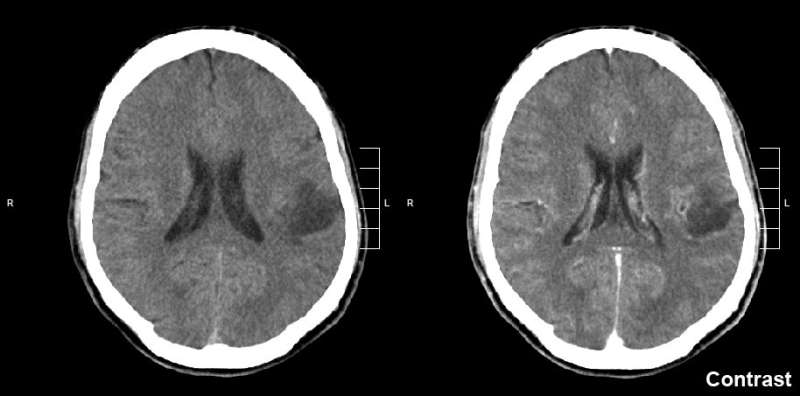Glioma of the left parietal lobe. CT scan with contrast enhancement. Credit: Mikhail Kalinin/CC BY-SA 3.0
The growth of brain cancers can be better understood with the help of a new computer platform developed by international scientists coordinated by Newcastle University.
The unique platform which can be used to help develop better treatments for glioma is freely available: biodynamo.org/
Publishing today in the journal Methods, the team from Newcastle University, the University of Cyprus, UCL and CERN describe how they have developed the three-dimensional model which brings together the macroscopic scale of tissue with the microscopic scale of individual cells. This allows the platform to realistically model cancer mechano-biology while maintaining the resolution power which makes it cost-effective.
Dr. Roman Bauer from the School of Computing said: "Built on top of the latest computing technologies, the BioDynaMo platform enables users to perform simulations on an increased scale and complexity making it possible to tackle challenging scientific research questions."
Although many specialised software tools exist, establishing this high-performance, general-purpose platform is a major step forward.
Jean de Montigny, Ph.D. student from the Faculty of Medical Sciences said: "The advantage for scientists and medics is that BioDynaMo can be used on standard laptops or desktop computers and provides a software platform which can be used to easily create, run and visualise 3-D agent-based biological simulations."
Glioma
Glioma is a broad category of brain and spinal cord tumours that originate from neural stem cells and glial cells that support neurons. Treatment for patients (who tend to be older adults) involves surgery to remove as much of the tumour as possible followed by chemotherapy and radiotherapy.
By modelling the growth of a glioma, clinicians can better understand how a tumour may develop and progress. Cancer researchers could use however such models in the future to improve the outcome of pertinent therapeutic procedures.
This paper develops a three-dimensional in silico hybrid model of cancer, which describes the multi-variate phenotypic behaviour of tumour and host cells. The model encompasses the role of cell migration and adhesion, the influence of the extracellular matrix, the effects of oxygen and nutrient availability, and the signalling triggered by chemical cues and growth factors.
Involving CERN, which contributed its deep knowledge in large-scale computing to this collaboration with Newcastle University, the project has been supported by Intel.
Moreover, the University of Cyprus and UCL investigators contributed with their expertise in multiscale modelling.
Biodynamo is an international collaboration partially funded by the CERN Budget for Knowledge Transfer to Medical Applications, through a grant awarded in 2016.
More information: Jean de Montigny et al, An in silico hybrid continuum-/agent-based procedure to modelling cancer development: Interrogating the interplay amongst glioma invasion, vascularity and necrosis, Methods (2020). DOI: 10.1016/j.ymeth.2020.01.006
Provided by Newcastle University





















